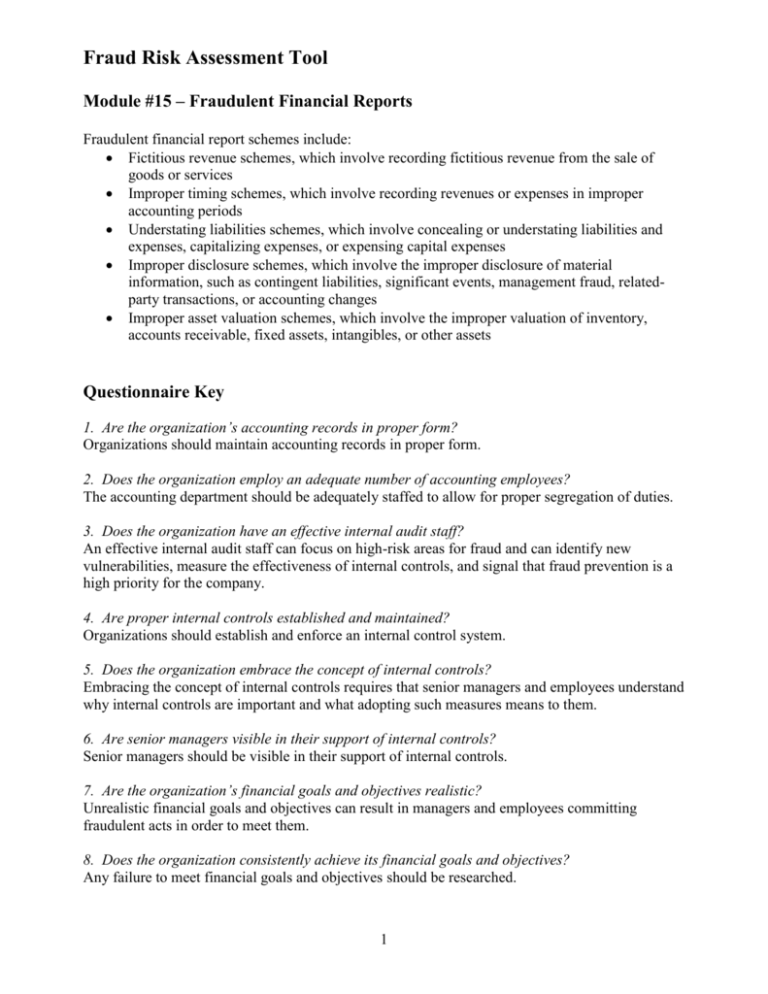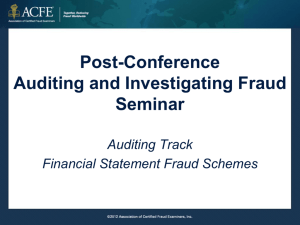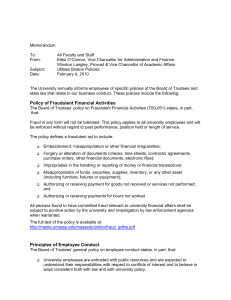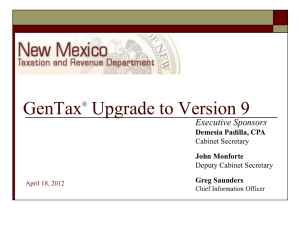Complete Module
advertisement

Fraud Risk Assessment Tool Module #15 – Fraudulent Financial Reports Fraudulent financial report schemes include: Fictitious revenue schemes, which involve recording fictitious revenue from the sale of goods or services Improper timing schemes, which involve recording revenues or expenses in improper accounting periods Understating liabilities schemes, which involve concealing or understating liabilities and expenses, capitalizing expenses, or expensing capital expenses Improper disclosure schemes, which involve the improper disclosure of material information, such as contingent liabilities, significant events, management fraud, relatedparty transactions, or accounting changes Improper asset valuation schemes, which involve the improper valuation of inventory, accounts receivable, fixed assets, intangibles, or other assets Questionnaire Key 1. Are the organization’s accounting records in proper form? Organizations should maintain accounting records in proper form. 2. Does the organization employ an adequate number of accounting employees? The accounting department should be adequately staffed to allow for proper segregation of duties. 3. Does the organization have an effective internal audit staff? An effective internal audit staff can focus on high-risk areas for fraud and can identify new vulnerabilities, measure the effectiveness of internal controls, and signal that fraud prevention is a high priority for the company. 4. Are proper internal controls established and maintained? Organizations should establish and enforce an internal control system. 5. Does the organization embrace the concept of internal controls? Embracing the concept of internal controls requires that senior managers and employees understand why internal controls are important and what adopting such measures means to them. 6. Are senior managers visible in their support of internal controls? Senior managers should be visible in their support of internal controls. 7. Are the organization’s financial goals and objectives realistic? Unrealistic financial goals and objectives can result in managers and employees committing fraudulent acts in order to meet them. 8. Does the organization consistently achieve its financial goals and objectives? Any failure to meet financial goals and objectives should be researched. 1 Fraud Risk Assessment Tool 9. Is the organization’s reported financial performance stable or increasing? Management should investigate any unstable or decreasing financial performance. 10. Does the company have stable relationships with its banks? The company should strive to have stable relationships with its banks. 11. Are there unrealistic changes or increases in financial statement account balances? Management should determine the reasons for any unrealistic changes or increases in financial statement account balances. 12. Are the account balances realistic given the nature, age, and size of the company? Management should investigate any unrealistic account balances. 13. Do actual physical assets exist in the amounts and values indicated on the financial statements? An inventory of physical assets should be conducted to verify that the physical assets exist in the amounts and values indicated on the financial statements. 14. Have there been significant changes in the nature of the organization’s revenues or expenses? The organization should determine the reasons for any significant changes in the nature of its revenues or expenses. 15. Do one or a few large transactions account for a significant portion of any account balance or amount? Situations in which one or a few large transactions account for a significant portion of any account balance or amount should be researched. 16. Are there significant transactions that occur near the end of a period that positively impact results of operations, especially transactions that are unusual or highly complex? Any significant transactions that occur near the end of a period and positively impact results of operations should be scrutinized for legitimacy, especially if the transactions are unusual or highly complex. 17. Are financial results fairly consistent across periods? The company should be able to explain any variances in financial results across periods. 18. Is there an inability to generate cash flows from operations while experiencing earnings growth? Any inability to generate cash flows from operations while experiencing earnings growth should be investigated. 19. Is there significant pressure to obtain additional capital necessary to stay competitive? Insufficient working capital can place undue pressure on management to manipulate financial results. 2 Fraud Risk Assessment Tool 20. Are reported assets, liabilities, revenues, or expenses based on significant estimates that involve unusually subjective judgments or uncertainties? Significant estimates, especially those that involve unusually subjective judgments or uncertainties, should be reviewed for reasonableness. 21. Are reported assets, liabilities, revenues, or expenses based on significant estimates that are subject to potential significant change in the near term in a manner that may have a financially disruptive effect on the organization? Significant estimates that are subject to potential significant change in the near term in a manner that may have a financially disruptive effect on the organization should be scrutinized. 22. Is the company experiencing unusually rapid growth or profitability, especially when compared with that of other companies in the same industry? Unusually rapid growth or profitability, especially when compared with that of other companies in the same industry, is a red flag of fraud and should be investigated. 23. Is the organization highly vulnerable to changes in interest rates? The organization should increase review of its financial reporting during periods of high vulnerability. 24. Are there unrealistically aggressive sales or profitability incentive programs? Unrealistically aggressive sales or profitability incentive programs can place undue pressure on employees and result in employees committing fraudulent acts in order to meet them. 25. Is there a threat of imminent bankruptcy, foreclosure, or hostile takeover? A threat of imminent bankruptcy, foreclosure, or hostile takeover places a company at increased risk for fraudulent activity to occur. 26. Is there a high possibility of adverse consequences on significant pending transactions, such as business combinations or contract awards, if poor financial results are reported? A high possibility of adverse consequences on significant pending transactions, such as business combinations or contract awards, if poor financial results are reported can place extreme pressure on management to manipulate results. 27. Is there a poor or deteriorating financial position when management has personally guaranteed significant debts of the entity? The existence of a poor or deteriorating financial position when management has personally guaranteed significant debts of the entity can result in management committing fraudulent acts in order to protect itself from financial harm. 28. Does the firm continuously operate on a crisis basis or without a careful budgeting and planning process? A careful budgeting and planning process can help a firm to monitor progress toward its goals, control spending, and predict cash flow and profit. 29. Does the organization have difficulty collecting receivables or have other cash flow problems? 3 Fraud Risk Assessment Tool Management should determine the reasons for any collection or cash flow problems. 30. Is the organization dependent on one or two key products or services, especially products or services that can become quickly obsolete? Dependence on one or two key products can place tremendous pressure on a company, exposing it to increased risk of fraud. 31. Do the footnotes contain information about complex issues? Any complex issues should be explained in the footnotes. 32. Are there adequate disclosures in the financials and footnotes? Generally accepted accounting principles concerning disclosures require that financial statements (1) include all relevant and material information in the financials or footnotes and (2) not be misleading. 4 Fraud Risk Assessment Tool Module 15- Fraudulent Financial Reports Yes Are the organization’s accounting records in proper form? Comments: Does the organization employ an adequate number of accounting employees? Comments: Does the organization have an effective internal audit staff? Comments: Are proper internal controls established and maintained? Comments: Does the organization embrace the concept of internal controls? Comments: Are senior managers visible in their support of internal controls? Comments: Are the organization’s financial goals and objectives realistic? Comments: Does the organization consistently achieve its financial goals and objectives? Comments: Is the organization’s reported financial performance stable or increasing? Comments: 5 No Not Applicable Fraud Risk Assessment Tool Module 15- Fraudulent Financial Reports Yes Does the company have stable relationships with its banks? Comments: Are there unrealistic changes or increases in financial statement account balances? Comments: Are the account balances realistic given the nature, age, and size of the company? Comments: Do actual physical assets exist in the amounts and values indicated on the financial statements? Comments: Have there been significant changes in the nature of the organization’s revenues or expenses? Comments: Do one or a few large transactions account for a significant portion of any account balance or amount? Comments: Are there significant transactions that occur near the end of a period that positively impact results of operations, especially transactions that are unusual or highly complex? Comments: Are financial results fairly consistent across periods? Comments: 6 No Not Applicable Fraud Risk Assessment Tool Module 15- Fraudulent Financial Reports Yes Is there an inability to generate cash flows from operations while experiencing earnings growth? Comments: Is there significant pressure to obtain additional capital necessary to stay competitive? Comments: Are reported assets, liabilities, revenues or expenses based on significant estimates that involve unusually subjective judgments or uncertainties? Comments: Are reported assets, liabilities, revenues, or expenses based on significant estimates that are subject to potential significant change in the near term in a manner that may have a financially disruptive effect on the organization? Comments: Is the company experiencing unusually rapid growth or profitability, especially when compared with that of other companies in the same industry? Comments: Is the organization highly vulnerable to changes in interest rates? Comments: Are the unrealistically aggressive sales or profitability incentive programs? Comments: 7 No Not Applicable Fraud Risk Assessment Tool Module 15- Fraudulent Financial Reports Yes Is there a threat of imminent bankruptcy, foreclosure, or hostile takeover? Comments: Is there a high possibility of adverse consequences on significant pending transactions, such as business combinations or contract awards, if poor financial results are reported? Comments: Is there a poor deteriorating financial position when management has personally guaranteed significant debts of the entity? Comments: Does the firm continuously operate on a crisis basis or without a careful budgeting and planning process? Comments: Does the organization have difficulty collecting receivables or have other cash flow problems? Comments: Is the organization dependent on one or two key products or services, especially products or services that can become quickly obsolete? Comments: Do the footnotes contain information about complex issues? Comments: Are there adequate disclosures in the financial of footnotes? Comments: 8 No Not Applicable








